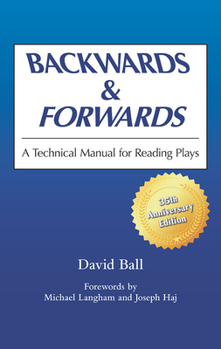Backwards & Forwards: A Technical Manual for Reading Plays
Select Format
Select Condition 
Book Overview
The best-selling script analysis book for thirty-five years Considered an essential text since its publication thirty-five years ago, this guide for students and practitioners of both theater and... This description may be from another edition of this product.
Format:Paperback
Language:English
ISBN:0809311100
ISBN13:9780809311101
Release Date:July 1983
Publisher:Southern Illinois University Press
Length:112 Pages
Weight:0.35 lbs.
Dimensions:0.3" x 5.3" x 8.4"
Customer Reviews
5 ratings
Required reading for anyone working on the stage!!
Published by Thriftbooks.com User , 18 years ago
I had a conversation yesterday in which the other theatre artist asked what approach this book advocated to script analysis: "is it feminist theory? queer theory? Marxist?" "No, it's the one where you read the script." Seriously, I don't know what I was doing in the theatre prior to reading this book, and I am so excited to begin my next project now because I feel that I have so much improved in my grasp of how to read a play. Why I wasn't required to read this book in Intro to Theatre or one of my first design classes I don't know, but I am so happy that I did now.
A great book to teach the art of reading and writing a play
Published by Thriftbooks.com User , 23 years ago
I have used this book as the basis of several theatre and playwriting classes that I have taught. Ball's language is simple, though the words he creates to explain his theories, such as "trigger" and "heap" (a trigger is the moment when people's motivations are exposed, while a heap is the result of that action) make it it easy for any non-theatre person to grasp the clever concepts. By having a person read a play backwards, Ball shows how to grasp the playwright's intentions, and the character's movements. It's a basic theatrical literary theatre that is surprisingly effective, especially in trying to teach young writers how to create a play.I highly recommend this book to the theatre neophyte as well as the theatre professional.
Demystifying the Playwriting Process
Published by Thriftbooks.com User , 24 years ago
David Ball's book is a must-have for all students and professors of theatre. It demystifies the playwriting process and presents a simple, down-to-earth explanation of why a playscript works the way it does. In a word, it explains how scripts work. I find the deceptively simple explanations help the novices in my Introduction to Theatre classes understand how playscripts are put together and make a fun game of script analysis for these students--a concept that is often hard to communicate to Intro students. At the same time, it make so much sense that it becomes the cornerstone for Beginning Directing, Playwriting, and Script Analysis students. Students whom I teach using Ball's ideas always come through the semester with a lot of self-esteem because having such a solid cornerstone allows their creativity to take off in unexpected directions.
An eye-opener for writers, readers, and play- & movie-goers
Published by Thriftbooks.com User , 25 years ago
A friend who teachs drama and directing at a local college recommended this book to me after he'd read a script I'd written. Not only is it a fast and interesting read, it offers simple and sometimes brilliant techniques for understanding and evaluating plays, movies, and even books. Even if you never plan to act or write, this well-written little book will enhance your appreciation of good story-telling. And if you ever had to endure discussions of "Hamlet" in high-school or college, you'll likely be surprised by Ball's unique take on the character as an example of dramatic writing.
A Must for Directors, New and Experienced
Published by Thriftbooks.com User , 26 years ago
David Ball's book on script analysis should be read and understood by anyone who directs plays. He explains how to read a play through the very simple technique of reading it from start to finish--and then backwards, from finish to start. By doing so, he points out, the reader learns how one scene leads logically and progressively to the next. While the concept is simple and straightforward, you have to read Ball's book to see how this process can be used to ferret out every important detail of plot and character development.






